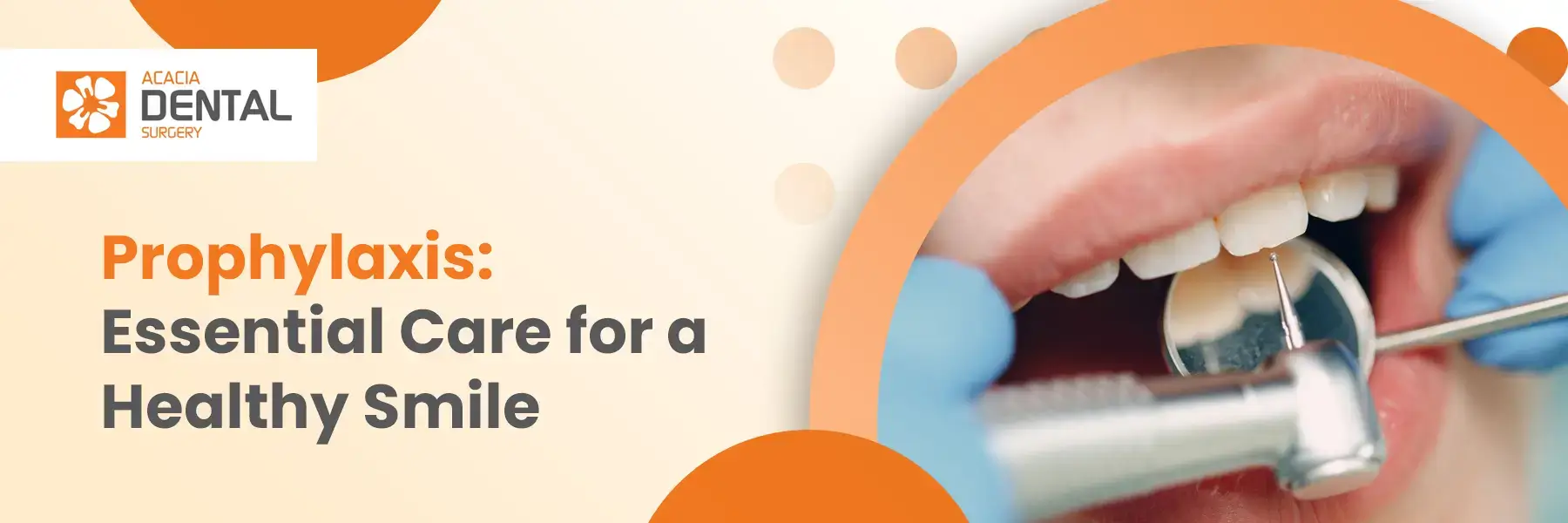
“Visit your dentist regularly” is a common advice growing up. It wasn’t just about clean teeth. It was about prevention, early detection, and building a habit that protects your health long-term. But have you ever had a dentist visit where your dentist says the word prophylaxis and then your face is in total wonder?
Prophylaxis is more than just a technical word in the dental world. It’s an essential part of maintaining your oral health and can make a significant difference in how your teeth and gums hold up over time. If you’ve ever asked yourself why routine cleaning is so important, or what exactly happens during a professional cleaning session, this guide is for you.
Let’s discuss what prophylaxis is, why you’ll need it, and how often you’ll need it done.
What Is Prophylaxis?
Prophylaxis in dentistry is a teeth cleaning performed by a dentist or hygienist. The objective is simple: stay ahead of the game and keep problems from even starting. Sure, brushing and flossing are a giant assist to a white smile within your own home, but your toothbrush simply cannot reach into some areas. That is where prophylaxis comes in.
The word is derived from the Greek term prophylaktikos, which means “to guard or to prevent.” Prophylaxis is a preventive dental treatment to protect your gums and teeth from gum disease, cavities, and other oral conditions.
What Does One Get at a Prophylaxis Appointment?
At a prophylaxis appointment, some things are to be mentioned other than your normal oral hygiene:
Scaling
The hygienist is scaling tartar and plaque buildup between your teeth and on the gumline. Tartar, or calculus, is accumulated plaque which can’t be dissolved by toothbrushing.
Polishing
Your teeth are polished with a gritty paste after scaling. It gets rid of the surface stains and prevents it being more prone in the future for plaque to stick.
Fluoride Treatment (Optional)
Most dentists will conclude with a fluoride treatment to strengthen enamel and protect against future cavities.
Oral Health Check
Your dentist will usually take a quick glance around your mouth, searching for indications of cavities, gum disease, or other problems that need attention.
The Purpose of Prophylaxis
So why all the commotion about getting your teeth professionally cleaned? Prophylaxis is good for several good reasons:
Prevention of Gum Disease: If plaque is not cleaned, gingivitis or extreme gum disease (periodontitis) and swelling can be initiated. Routine prophylaxis keeps the gums from infection and keeps them healthy.
Prevention of Cavities: Plaque removal and tartar cleaning also avoids the bacteria that cause tooth decay.
Early Detection of Dental Problems: Such appointments typically detect early signs of dental distress. Early detection of problems usually means less expensive and less involved repairs.
Improve Breath: Persistent bad breath usually is a symptom of bacterial accumulation. Prophylaxis removes the cause.
Overall Health Boost: There is growing evidence that your oral health correlates with your overall health. Gum disease has been linked to such diseases as heart disease and diabetes, so a healthy mouth could have benefits other than your smile.
Who Needs Prophylaxis?
The short answer? Everyone.
Plaque continues to be deposited in hard-to-reach spots. Kids, teens, adults, and older patients alike can benefit from regular prophylaxis appointments. Even without underlying pain or apparent problems, professional cleaning prevents it.
For the people with crowns, implants and braces, prophylaxis is optimal. These tooth structures take up more space in which food particles and bacteria tend to settle and hence require cleaning on a bigger scale.
How Often to Have Prophylaxis?
Most people can have a procedure of prophylaxis carried out every six months, as advised by dentists. Biannual should be enough to prevent the deposition of tartar and to identify early signs of trouble.
However, some people may need more frequent visits depending on their oral health:
Every 3–4 months: For patients with a history of gum disease or those prone to heavy plaque buildup.
Every 4 months: For smokers, diabetics, or those with compromised immune systems.
As advised: If you’re undergoing specific treatments or have certain dental appliances, your dentist might suggest a tailored schedule.
The procedure to find out how often is best for you is to visit your dentist. The dentist will examine your mouth and inform you of what your optimal interval should be.
A Healthier Smile Begins with Prophylaxis
Routine dental cleaning isn’t just about keeping your teeth looking white. It is maintaining your oral hygiene for the future. One of the most effective prevention treatments offered by a dentist is prophylaxis and one of the easiest things you can do to avoid more invasive dental work in the future.
Conclusion
Keep Your Smile Strong with Acacia Dental. If it has been some time since your previous professional dental cleaning, the moment is now to prioritise your oral health. Acacia Dental facilitates prophylaxis as a painless, speedy procedure with personal care.
Our professional dentists with advanced dental technology are ready to put your gums and teeth into their best state. New patient or in need of your six-month checkup, we encourage you to smile.
Book your prophylaxis today at Acacia Dental because an ounce of prevention is better than a pound of cure.